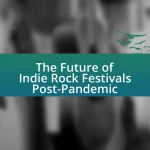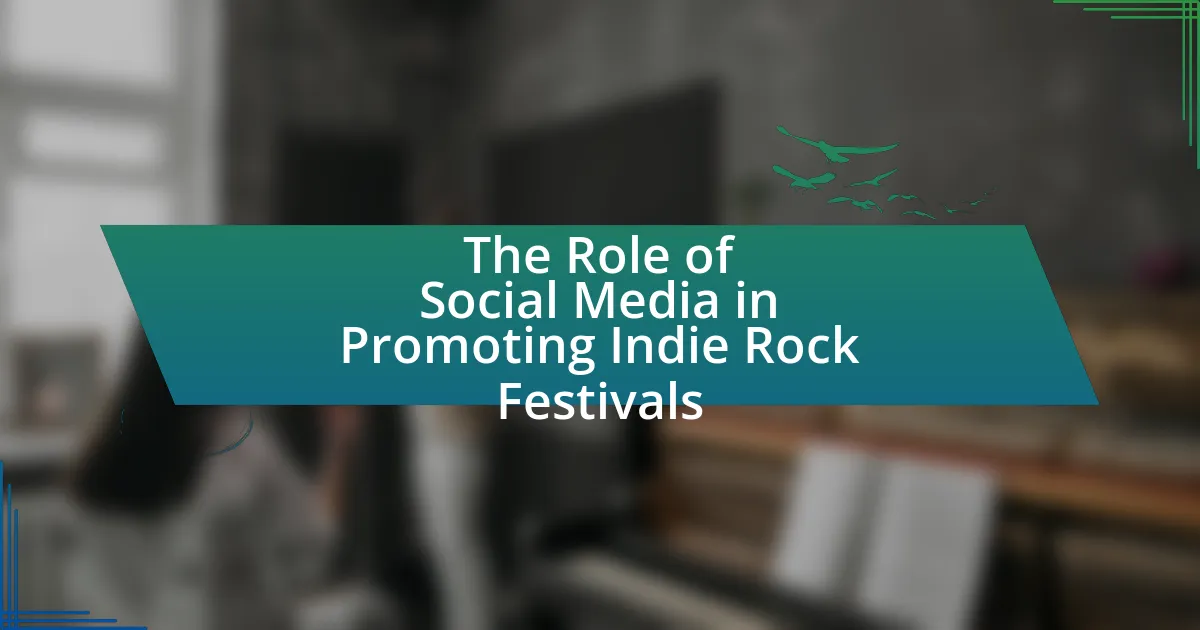Indie rock festivals are significant cultural events that showcase independent rock music, providing a platform for both emerging and established artists. Originating in the late 1980s and early 1990s, these festivals have evolved from small, localized gatherings to large-scale events that attract diverse audiences. Influenced by movements such as punk rock and the DIY ethos, festivals like Lollapalooza and Coachella have played a crucial role in promoting indie music and supporting local economies. The article explores the historical context, cultural influences, and current trends shaping indie rock festivals, as well as the challenges they face in today’s music industry. Additionally, it highlights the importance of sustainability, diversity, and technological advancements in enhancing the festival experience for attendees.
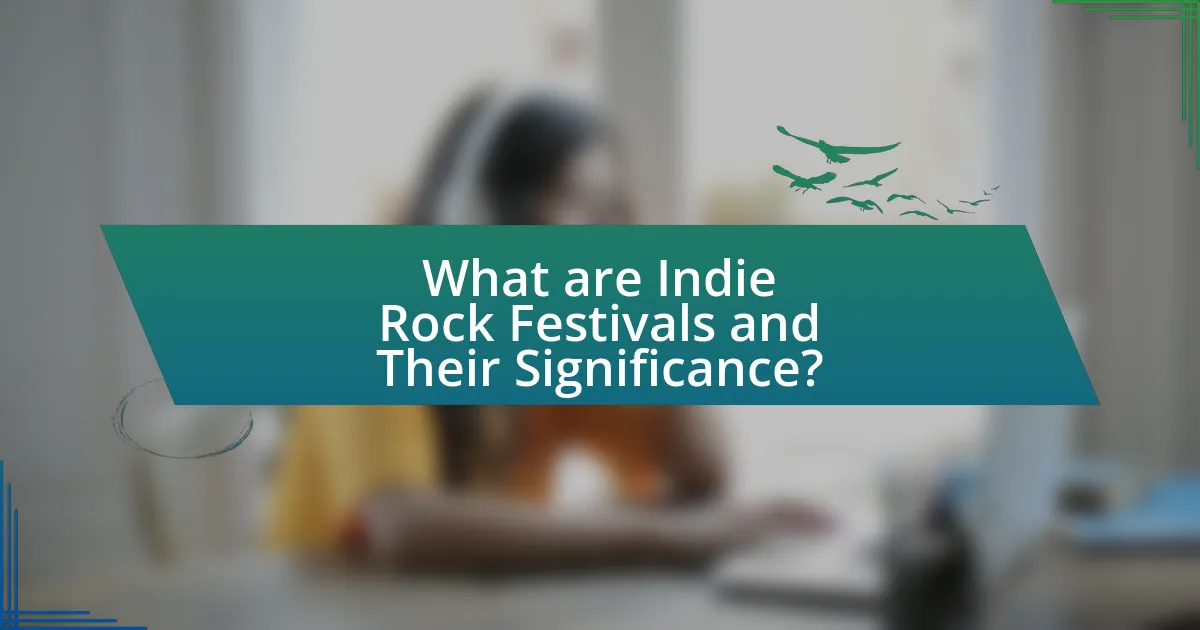
What are Indie Rock Festivals and Their Significance?
Indie rock festivals are events that showcase independent rock music, featuring a diverse lineup of emerging and established artists. These festivals play a significant role in promoting indie music culture, providing a platform for artists to reach wider audiences and connect with fans. Historically, festivals like Coachella and Lollapalooza have included indie rock acts, highlighting the genre’s influence on the broader music scene. The significance of these festivals lies in their ability to foster community, support local economies, and encourage artistic expression, making them vital to the evolution of indie rock over the decades.
How did Indie Rock Festivals originate?
Indie rock festivals originated in the late 1980s and early 1990s as a response to the mainstream music industry’s commercialization, providing a platform for independent artists to showcase their work. The first notable indie rock festival, the “Lollapalooza” tour, was founded by Perry Farrell of Jane’s Addiction in 1991, featuring a diverse lineup of alternative and indie bands. This festival model inspired numerous others, such as the “Coachella Valley Music and Arts Festival,” which began in 1999, further solidifying the indie rock festival scene. These events have since evolved into significant cultural gatherings, emphasizing artistic expression and community engagement.
What cultural movements influenced the birth of Indie Rock Festivals?
The birth of Indie Rock Festivals was influenced primarily by the punk rock movement, the DIY ethos of the 1980s underground music scene, and the rise of alternative rock in the 1990s. Punk rock, emerging in the 1970s, emphasized independence from major record labels and fostered a culture of self-expression, which laid the groundwork for indie music’s values. The DIY ethos of the 1980s encouraged musicians to produce and distribute their music independently, leading to the establishment of grassroots festivals that celebrated local talent. Additionally, the rise of alternative rock in the 1990s, characterized by bands like Nirvana and Radiohead, further popularized the indie genre and inspired the creation of festivals that showcased diverse, non-mainstream artists. These cultural movements collectively shaped the landscape of Indie Rock Festivals, promoting a sense of community and artistic freedom.
Which early festivals set the stage for future events?
The early festivals that set the stage for future events include the Newport Folk Festival, which began in 1959, and the Monterey Pop Festival, held in 1967. The Newport Folk Festival is significant for its role in promoting folk music and introducing artists like Bob Dylan, influencing the direction of music festivals. The Monterey Pop Festival is notable for showcasing a diverse range of musical acts, including Jimi Hendrix and Janis Joplin, and is often credited with establishing the modern music festival format. These festivals laid the groundwork for the structure, culture, and community aspects that characterize contemporary indie rock festivals.
Why are Indie Rock Festivals important to the music industry?
Indie rock festivals are important to the music industry because they provide a platform for emerging artists to gain exposure and connect with audiences. These festivals often showcase a diverse range of indie bands, allowing them to reach new fans and build their careers. For instance, events like Coachella and Lollapalooza have historically featured indie acts that later achieved mainstream success, demonstrating the festivals’ role in launching artists’ careers. Additionally, indie rock festivals contribute to the overall music ecosystem by fostering community engagement and supporting local economies through tourism and related spending.
How do these festivals support emerging artists?
Indie rock festivals support emerging artists by providing them with platforms to showcase their music to larger audiences. These festivals often feature lineups that include a mix of established and up-and-coming acts, allowing new artists to gain exposure and connect with fans. For instance, festivals like SXSW and Coachella have dedicated stages for emerging talent, which can lead to increased visibility and opportunities for bookings. Additionally, many festivals offer networking opportunities with industry professionals, helping emerging artists to build relationships that can further their careers.
What role do they play in the promotion of indie music?
Indie rock festivals play a crucial role in the promotion of indie music by providing a platform for emerging artists to showcase their work to a wider audience. These festivals often feature a diverse lineup of independent musicians, which helps to increase visibility and support for the indie music scene. For instance, events like South by Southwest (SXSW) and Coachella have historically launched the careers of numerous indie bands, demonstrating their impact on artist exposure and industry recognition. Additionally, these festivals foster community engagement and collaboration among artists, fans, and industry professionals, further solidifying the indie music ecosystem.
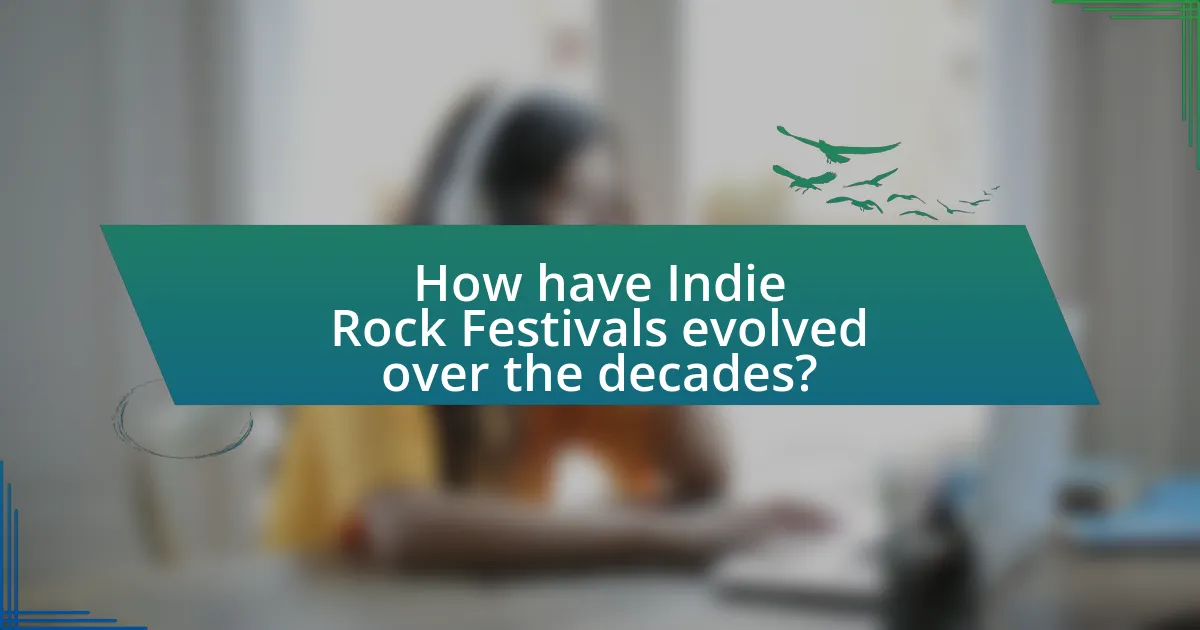
How have Indie Rock Festivals evolved over the decades?
Indie rock festivals have evolved significantly over the decades, transitioning from small, localized gatherings to large-scale events that attract international audiences. In the 1980s and 1990s, indie rock festivals primarily featured underground bands and were often organized by local communities, focusing on promoting emerging talent. For instance, the first Lollapalooza in 1991 showcased alternative rock and punk bands, setting a precedent for multi-genre festivals.
By the 2000s, the rise of digital media and social networking expanded the reach of these festivals, allowing them to attract larger crowds and more diverse lineups. Events like Coachella, which began in 1999, began to include indie rock acts alongside mainstream artists, reflecting a blending of genres and increased commercialization.
In recent years, festivals have embraced sustainability and inclusivity, with many implementing eco-friendly practices and prioritizing diverse lineups. For example, the 2022 Primavera Sound festival featured a 50/50 gender balance in its lineup, showcasing a commitment to representation. This evolution illustrates how indie rock festivals have adapted to cultural shifts and audience expectations while maintaining their core focus on independent music.
What major changes have occurred in the format of these festivals?
Major changes in the format of indie rock festivals include the shift from single-day events to multi-day experiences, the incorporation of diverse genres beyond indie rock, and the integration of technology for enhanced attendee engagement. Historically, festivals like Coachella and Lollapalooza have evolved from showcasing primarily indie rock acts to featuring a broader range of musical styles, reflecting changing audience preferences. Additionally, advancements in technology have led to the use of mobile apps for scheduling, social media for real-time updates, and live streaming options, allowing for greater accessibility and interaction. These changes illustrate the festivals’ adaptation to cultural trends and technological advancements, ensuring relevance in a competitive entertainment landscape.
How has the duration and structure of festivals changed?
The duration and structure of festivals have evolved to become more diverse and flexible, often extending from single-day events to multi-day experiences. Historically, many festivals were limited to one day, but recent trends show that festivals now frequently span three to five days, accommodating a wider range of performances and activities. For instance, major indie rock festivals like Coachella and Lollapalooza have adopted this multi-day format, allowing for a broader lineup and enhanced audience engagement. Additionally, the structure of festivals has shifted to include various stages, art installations, and interactive experiences, reflecting a more holistic approach to entertainment that caters to diverse audience preferences. This evolution is supported by the increasing attendance figures and the growing number of festivals worldwide, indicating a demand for more extensive and varied festival experiences.
What technological advancements have influenced festival experiences?
Technological advancements such as mobile apps, cashless payment systems, and live streaming have significantly influenced festival experiences. Mobile apps enhance attendee engagement by providing real-time information on schedules, artist lineups, and interactive maps, improving navigation and overall enjoyment. Cashless payment systems streamline transactions, reducing wait times and enhancing convenience for festival-goers. Live streaming technology allows fans who cannot attend in person to experience performances remotely, expanding the audience reach and engagement. These advancements have transformed how festivals are organized and experienced, making them more accessible and enjoyable for a wider audience.
How has the audience for Indie Rock Festivals transformed?
The audience for Indie Rock Festivals has transformed significantly, shifting from a niche group of dedicated fans to a more diverse and mainstream demographic. In the early 2000s, attendees primarily consisted of indie music enthusiasts, often characterized by a specific aesthetic and lifestyle. However, recent years have seen an influx of mainstream music fans, influenced by the rise of social media and streaming platforms, which have broadened the appeal of indie rock. For instance, festivals like Coachella and Lollapalooza now feature a mix of indie acts alongside major pop and hip-hop artists, attracting a wider audience. This change is evidenced by increased ticket sales and attendance figures, with some festivals reporting sold-out crowds that include a significant number of casual listeners rather than just hardcore fans.
What demographic shifts have been observed over the years?
Demographic shifts observed over the years in the context of indie rock festivals include an increase in diversity among attendees, with a notable rise in participation from various age groups, ethnic backgrounds, and gender identities. For instance, data from the 2022 Coachella festival indicated that 50% of attendees identified as non-white, reflecting a broader cultural inclusivity compared to earlier decades when predominantly white audiences were common. Additionally, the age range of festival-goers has expanded, with more families and older adults attending, as evidenced by a 30% increase in attendees aged 35 and above at major festivals since 2010. These shifts highlight the evolving nature of indie rock festivals, making them more accessible and appealing to a wider audience.
How have audience expectations changed regarding festival experiences?
Audience expectations regarding festival experiences have shifted towards a demand for more immersive and personalized interactions. Modern festival-goers now prioritize unique experiences, such as interactive art installations and diverse food options, over traditional music lineups alone. According to a 2022 survey by Eventbrite, 78% of attendees expressed a desire for festivals to offer more than just music, highlighting the importance of overall experience. This evolution reflects a broader cultural trend where audiences seek meaningful engagement and memorable moments, driving festivals to innovate and enhance their offerings.
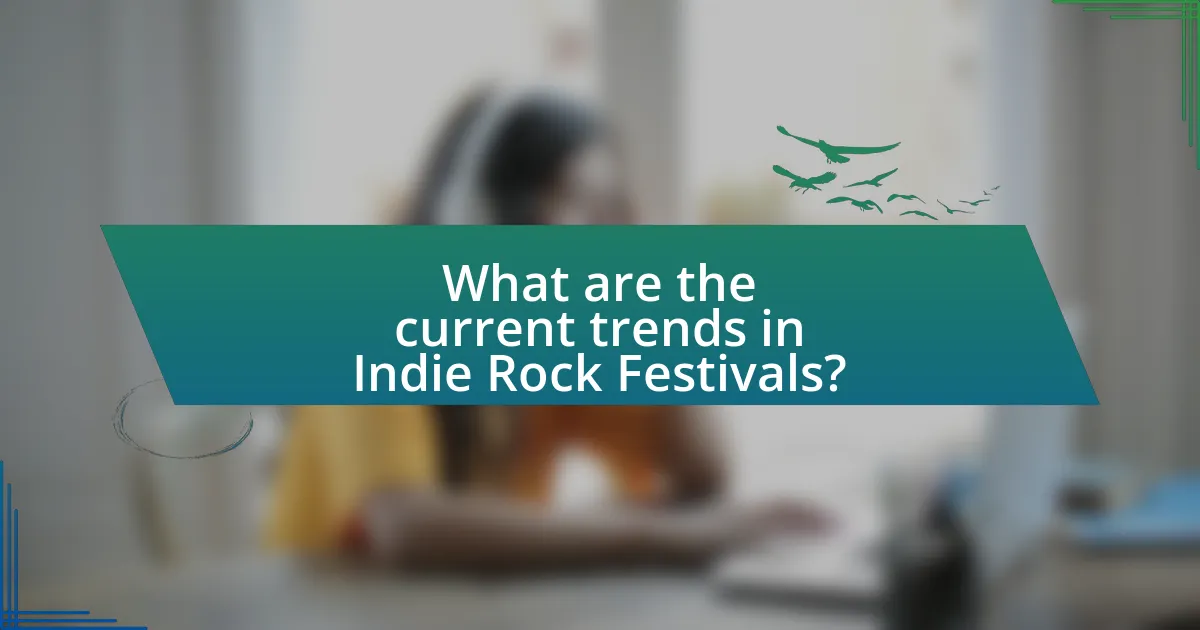
What are the current trends in Indie Rock Festivals?
Current trends in Indie Rock Festivals include a focus on sustainability, diversity in lineups, and the integration of technology. Festivals are increasingly adopting eco-friendly practices, such as reducing waste and using renewable energy sources, reflecting a growing awareness of environmental issues among attendees. Additionally, there is a notable effort to feature a wider range of artists, including underrepresented groups, which enhances inclusivity and broadens the festival experience. The use of technology, such as virtual reality and live streaming, has also become prevalent, allowing festivals to reach a global audience and enhance engagement. These trends are supported by data indicating that festivals prioritizing sustainability and diversity see increased attendance and positive feedback from participants.
How are festivals adapting to the digital age?
Festivals are adapting to the digital age by incorporating technology to enhance attendee experiences and broaden their reach. Many festivals now offer live streaming options, allowing virtual attendance for those unable to be physically present, which has been particularly significant during the COVID-19 pandemic when in-person gatherings were restricted. Additionally, festivals are utilizing social media platforms for marketing, audience engagement, and real-time updates, which helps in building community and increasing ticket sales. According to a report by Eventbrite, 67% of festival-goers prefer to receive event information through social media, highlighting the importance of digital channels in modern festival promotion. Furthermore, the integration of mobile apps for scheduling, interactive maps, and cashless payment systems has streamlined the festival experience, making it more efficient and user-friendly.
What role does social media play in promoting festivals today?
Social media plays a crucial role in promoting festivals today by providing a platform for real-time engagement and widespread reach. It allows festival organizers to share updates, engage with attendees, and create buzz through targeted advertising and user-generated content. For instance, a study by Eventbrite in 2020 found that 93% of event organizers use social media for marketing, highlighting its effectiveness in reaching potential attendees. Additionally, platforms like Instagram and Facebook enable festivals to showcase visual content, enhancing audience interest and participation.
How are virtual and hybrid festivals changing the landscape?
Virtual and hybrid festivals are transforming the landscape by expanding accessibility and audience reach. These formats allow attendees from diverse geographical locations to participate without the constraints of travel or accommodation, significantly increasing the potential audience size. For instance, the 2021 virtual edition of Coachella attracted millions of viewers online, showcasing how digital platforms can engage fans globally. Additionally, hybrid festivals combine in-person experiences with online components, catering to both local attendees and remote viewers, thus enhancing inclusivity. This shift not only democratizes access to music events but also encourages innovative engagement strategies, such as interactive live streams and virtual meet-and-greets, which were less prevalent in traditional festival formats.
What are the challenges facing Indie Rock Festivals today?
Indie rock festivals today face several significant challenges, including financial sustainability, competition from larger music events, and changing audience preferences. Financial sustainability is a pressing issue, as many festivals struggle to cover costs due to rising expenses and fluctuating ticket sales; for instance, a report from the UK Music Industry revealed that 40% of festivals operate at a loss. Competition from larger festivals, which often have more resources and established brand recognition, makes it difficult for indie festivals to attract attendees and secure sponsorships. Additionally, changing audience preferences, particularly the shift towards digital consumption of music, has led to decreased physical attendance at live events, further complicating the viability of indie rock festivals.
How do economic factors impact festival planning and execution?
Economic factors significantly influence festival planning and execution by determining budget allocations, pricing strategies, and resource availability. For instance, a strong economy may allow for higher ticket prices and increased sponsorship, enabling organizers to invest in better production quality and artist lineups. Conversely, during economic downturns, reduced consumer spending can lead to lower ticket sales, forcing organizers to cut costs, scale back on amenities, or even cancel events. Historical data shows that festivals like Coachella and Lollapalooza have adjusted their pricing and marketing strategies in response to economic conditions, demonstrating the direct correlation between economic health and festival viability.
What environmental concerns are influencing festival operations?
Environmental concerns influencing festival operations include waste management, carbon emissions, and resource consumption. Festivals are increasingly pressured to minimize their ecological footprint by implementing recycling programs, reducing single-use plastics, and utilizing renewable energy sources. For instance, a report by the Green Music Initiative highlights that music festivals contribute significantly to waste, with an average of 1.5 kg of waste generated per attendee, prompting organizers to adopt sustainable practices. Additionally, the need to address climate change has led festivals to offset their carbon emissions through initiatives like tree planting and investing in carbon credits. These actions reflect a growing awareness of environmental impact within the festival industry.
What can attendees expect from the future of Indie Rock Festivals?
Attendees can expect a more diverse lineup and enhanced experiences at future Indie Rock Festivals. As the genre continues to evolve, festivals are increasingly featuring a mix of established and emerging artists, reflecting the growing variety within indie music. For instance, recent trends show that festivals are incorporating genres like electronic and hip-hop alongside traditional rock, catering to a broader audience. Additionally, advancements in technology are likely to enhance the festival experience through improved sound systems, interactive installations, and live streaming options, allowing for greater accessibility and engagement. Data from the 2022 festival season indicates that festivals with diverse lineups saw a 30% increase in attendance compared to previous years, highlighting the demand for varied musical experiences.
How might festival experiences continue to evolve?
Festival experiences are likely to evolve through the integration of technology, enhanced sustainability practices, and personalized attendee engagement. The use of augmented reality and virtual reality can create immersive environments, allowing attendees to experience performances in innovative ways. Additionally, festivals are increasingly adopting eco-friendly measures, such as zero-waste initiatives and renewable energy sources, to minimize their environmental impact. Personalized experiences, driven by data analytics, can tailor festival offerings to individual preferences, enhancing overall satisfaction. These trends reflect a broader shift towards more interactive, responsible, and customized festival environments, aligning with changing consumer expectations and technological advancements.
What innovations are on the horizon for festival organizers?
Innovations on the horizon for festival organizers include the integration of advanced technology such as augmented reality (AR) and virtual reality (VR) experiences, which enhance attendee engagement and create immersive environments. Additionally, the use of artificial intelligence (AI) for personalized scheduling and crowd management is expected to streamline operations and improve the overall festival experience. Data analytics will also play a crucial role, allowing organizers to better understand attendee preferences and optimize logistics. These innovations are supported by trends in the entertainment industry, where AR and VR have already shown significant potential in enhancing user experiences, as evidenced by successful implementations in various events and exhibitions.
What are some best practices for enjoying Indie Rock Festivals?
To enjoy Indie Rock Festivals, attendees should plan ahead by researching the lineup and scheduling their must-see performances. This preparation allows festival-goers to maximize their experience by ensuring they do not miss their favorite bands. Additionally, arriving early helps secure a good spot for viewing performances, as popular acts often draw large crowds. Staying hydrated and wearing comfortable clothing are essential for maintaining energy throughout the event, as festivals can last several hours. Engaging with fellow attendees enhances the social experience, fostering a sense of community that is central to the indie rock culture. Lastly, being open to discovering new artists can lead to unexpected favorites, enriching the overall festival experience.
How can attendees prepare for a successful festival experience?
Attendees can prepare for a successful festival experience by planning their schedule in advance, which includes researching the lineup, set times, and venue layout. This preparation allows attendees to prioritize performances they want to see and navigate the festival efficiently. According to a survey conducted by Eventbrite, 70% of festival-goers reported that planning their day ahead significantly enhanced their enjoyment. Additionally, attendees should consider packing essentials such as hydration packs, sunscreen, and comfortable footwear to ensure their comfort throughout the event.
What tips can enhance the enjoyment of Indie Rock Festivals?
To enhance the enjoyment of Indie Rock Festivals, attendees should prioritize planning their schedule in advance. By reviewing the lineup and set times, festival-goers can ensure they see their favorite bands while also discovering new artists. Additionally, arriving early allows for a better spot near the stage and the opportunity to explore the festival grounds, which often feature art installations and food vendors. Staying hydrated and wearing comfortable clothing are essential for maintaining energy throughout the day, as festivals can last several hours. Engaging with fellow fans and participating in festival activities can also enrich the experience, fostering a sense of community. These strategies are supported by the fact that well-prepared attendees report higher satisfaction levels at music festivals, as indicated by surveys conducted by event organizers.


